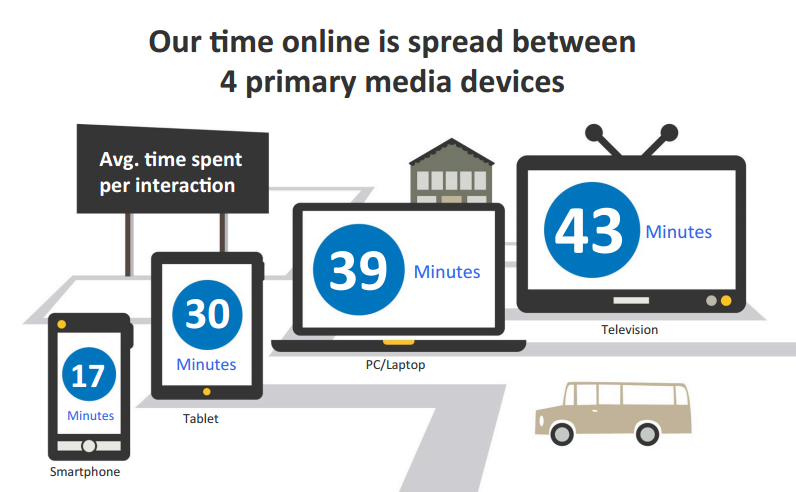In 2013, Reuters produced a report claiming more focus would be placed on the production of larger screens, to satisfy consumer demand worldwide. This trend is being pushed by both a need for versatility and a reduction in the costs of producing large screens. This means that developers now have an even wider range of screen sizes to cater for when producing content, whether for apps or the web. You can learn more about devices in use around the world if you register for a free DeviceAtlas account.
Google Research on Screen Sizes
Screen size matters more than content creators think. For starters, look at this research from Google that shows how engagement increases with screen size.
Image: Google
This makes sense, as people consume content differently on different screen sizes. 4-5” phones are great for checking emails, tweets, social networks (especially uploading photos you took on your phone), listening to music, and playing casual games like Angry Birds. Larger screen sizes are more useful for reading, playing more serious games, watching visual content like Netflix or Hulu, and getting some work done.
Large Screen Device Sales
Worldwide phablet sales are expected to hit 24.4% market share with 592.9 million units shipped during 2018, according to a mobiForge’s mobile market statistics compilation. Moreover, phablets are expected to outsell tablets within the next few years. Smartphone/tablet penetration is plateauing in Western markets with a trend towards larger screens. Smartphone penetration is growing at 30% in emerging markets year on year (IDC).
Screen Size Disparity across Countries
Device usage is not uniform across the globe. There are a number of contributing factors including economic prosperity and equality, and strength of the carrier’s technical offering in each market. To gather this data, I used DeviceAtlas’ Data Explorer, which contains data on over 16,000 different devices worldwide. You can browse through this if you register for a free DeviceAtlas account. I chose 10 countries (chosen for variety) and gathered statistics for 11 different screen sizes from 3.5 inches up to 5.7 inches. Countries chosen include the USA, the UK, France, Germany, Spain, Italy, Japan, China, South Korea and Australia.
Less Expensive Devices
It’s no surprise to see that the majority of users in all countries stick to the less expensive devices in the 3.5 to 4 inch range. This chart shows the percentage of users on small devices by country.
The less technologically developed nations tend to gravitate towards smaller screens, with 82% of users in China using devices with a screen size of 4 inches or smaller. To contrast this, in South Korea (the country leading internet speed and usage charts worldwide) just 16.9% of consumers use devices with a screen size of 4 inches or less.
The High End of the Market
The USA, Germany, Spain and South Korea lead in the uptake of larger devices, with more than 20% of the population using devices with screen sizes of 5 inches plus. The introduction of the iPhone 6 Plus in October 2014 should boost these numbers throughout 2015 and beyond.
South Korea leads the way with over 45% of users with large screen devices. One surprise is Japan, with a lower than expected number of users engaging with larger devices. Less than 7% of users in China engage with large screen devices. This chart shows the percentage of users on large devices by country.
Image from Flickr.




